
The Hague School is a group of artists who lived and worked in The Hague between 1860 and 1890. Their work was heavily influenced by the realist painters of the French Barbizon school. The painters of the Hague school generally made use of relatively somber colors, which is why the Hague School is sometimes called the Gray School.

Katwijk aan Zee is a seaside resort located on the North Sea at the mouth of the Oude Rijn. It is situated in the municipality of Katwijk and the province of South Holland.

Pieter van Bloemen, also known as Standaart, first name also spelled Peter or Peeter, was a Flemish painter. He was a gifted landscape and animal painter and was very successful with his compositions depicting equestrian, animal and market scenes.

Balthasar van den Bossche (1681–1715) was a Flemish painter who is mainly known for his wide range of genre subjects and occasional portraits.
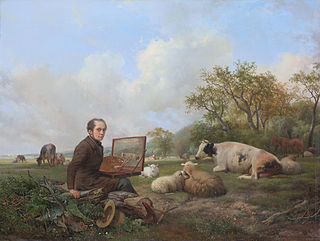
Hendrik (Hendrikus) van de Sande Bakhuyzen was a Dutch landscape painter and art teacher. He was a prominent contributor to the Romantic period in Dutch art and his students and children founded the art movement known as the Hague School. Like his contemporaries Edward Williams, Jacob Maris, and Jozef Israels, he was part of a family of prominent painters, including son Julius van de Sande Bakhuyzen, daughter Gerardina Jacoba van de Sande Bakhuyzen, and nephew Alexander Hieronymus Bakhuyzen.
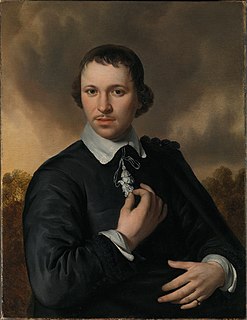
Jan van de Cappelle was a Dutch Golden Age painter of seascapes and winter landscapes, also notable as an industrialist and art collector. He is "now considered the outstanding marine painter of 17th century Holland". He lived all his life in Amsterdam, and as well as working as an artist spent much, or most, of his time helping to manage his father Franchoy's large dyeworks, which specialized in the expensive dye carmine, and which he eventually inherited in 1674. Presumably because of this dual career, there are fewer than 150 surviving paintings, a relatively small number for the industrious painters of the Dutch Golden Age. His marine paintings usually show estuary or river scenes rather than the open sea, and the water is always very calm, allowing it to act as a mirror reflecting the cloud formations above; this effect was Cappelle's speciality.
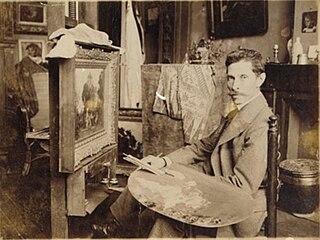
Johannes Evert Hendrik Akkeringa was part of the second generation of the Hague School painters. Akkeringa is primarily known for his paintings and watercolours of women and playing children at the beach, women mending nets and intimate tea-time conversations.
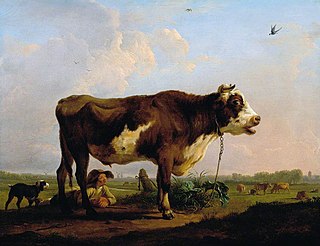
Balthasar Paul Ommeganck (1755–1826) was a Flemish painter of landscapes and animals active in Antwerp. Through his work and his role as an art teacher and founder of art institutions he gave an important impetus to the revitalization of landscape painting in the Low Countries.
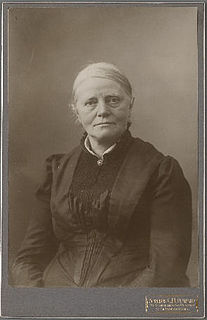
Sina (Sientje) van Houten was the wife of Hendrik Willem Mesdag, the Dutch marine painter of the Hague School, and a painter herself.

Aert van den Bossche or the Master of the Crispinus and Crispinianus-Legend was an Early Netherlandish painter of altarpieces, active in Brussels and Bruges in the late 15th century. There is still doubt as to whether he should be identified with the Master of the legend of St. Barbara or was only one of the artists active in a workshop responsible for the works of that master.
Jules Félicien Romain Stanislas van den Bossche was a Dutch military officer and colonial government official. He was governor of the Dutch Gold Coast between 1857 and 1858 and member of the Council of the Dutch East Indies, the government of the Governor-General of the Dutch East Indies.

Tjeerd (Tsjeard) Bottema was a Dutch painter, illustrator and book cover designer.

Bernardus Antonie van Beek was a Dutch landscape painter. He never attended an academy. He was part of the Kortenhoef School, a sub-movement of the Hague School and is thus in the tradition of Barbizon School. From his choice of motifs, there are also influences of the Amsterdam Impressionism. His work was part of the painting event in the art competition at the 1928 Summer Olympics.

Erasmus de Bie was a Flemish Baroque painter known for his city views and genre scenes. He depicted several lively scenes of large public celebrations in his hometown of Antwerp. It is not clear whether the views of Italianate cities and landscapes attributed to him are the work of Adriaen de Bie, a Flemish painter from Lier who worked in Italy for a while.

Jan Hillebrand Wijsmuller was a Dutch painter. He belongs to The 2. Golden Age of Dutch Painting.
The Laren School is the name of an art colony located in the Dutch village, Laren, in Het Gooi near Hilversum. The artists of this offshoot of the Hague School chose the inhabitants of Laren and the surrounding landscape as the subject of their art.
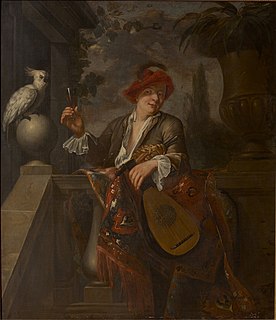
François Xaver Henri Verbeeck or Frans Verbeeck was a Flemish painter known mainly for his genre scenes and paintings of merry and gallant companies.

Simon Moulijn was a Dutch painter, draughtsman and graphic artist. He was one of the eminent visual artists of his time and became especially well known for his lithographic works.

Joseph Middeleer was a Belgian painter and aquarellist known for his genre scenes, figures, landscapes and still lifes. He was an academically trained artist whose style and themes reflected initially the retro genre style of Belgian Romantic-historical painting. He also dealt with social realist themes and in the 1890s he painted a number of symbolist works.
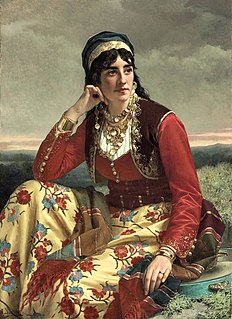
Jan Frederik Pieter Portielje was a Dutch-Belgian painter of genre scenes and portraits; mostly of women.






















